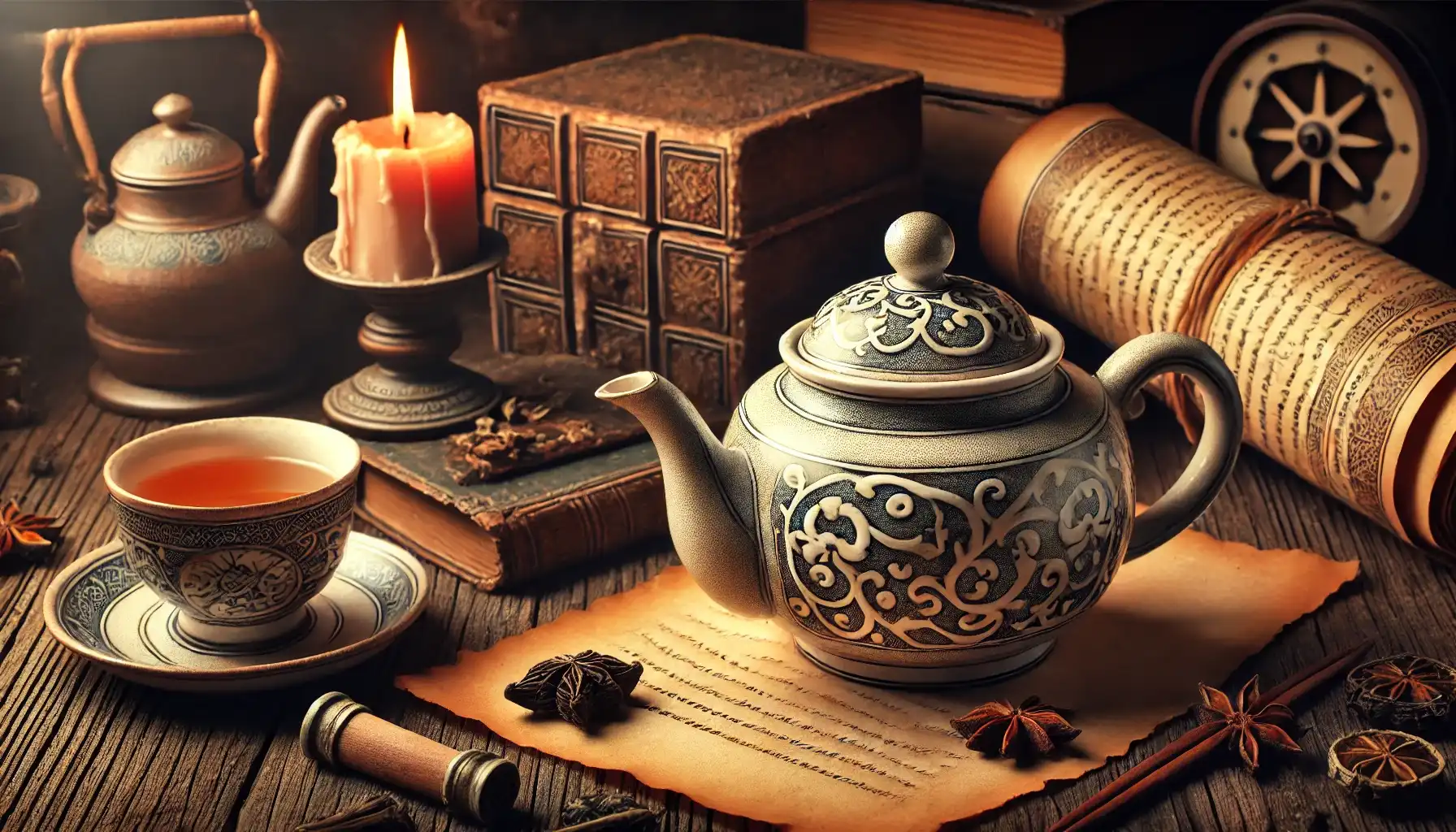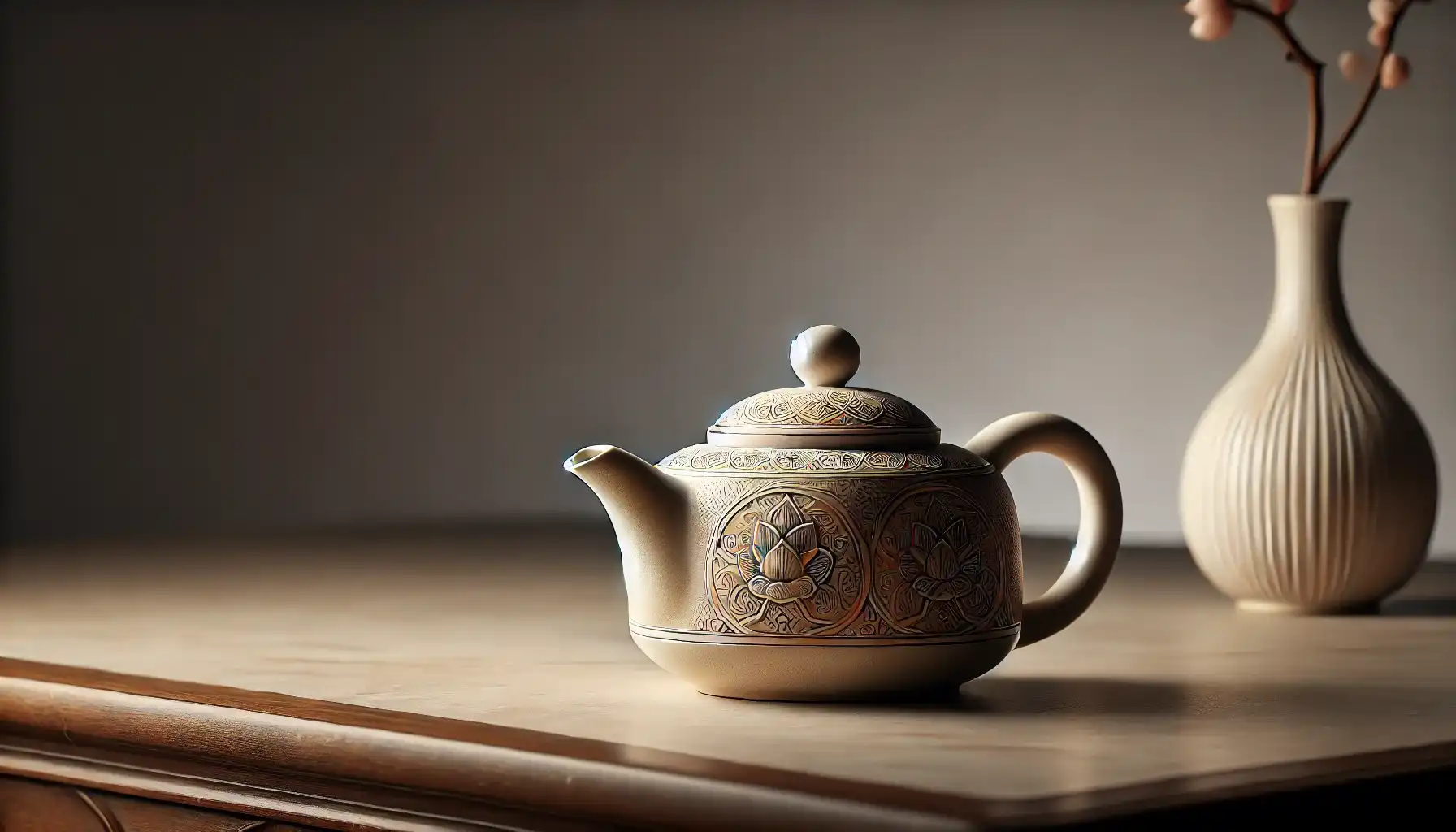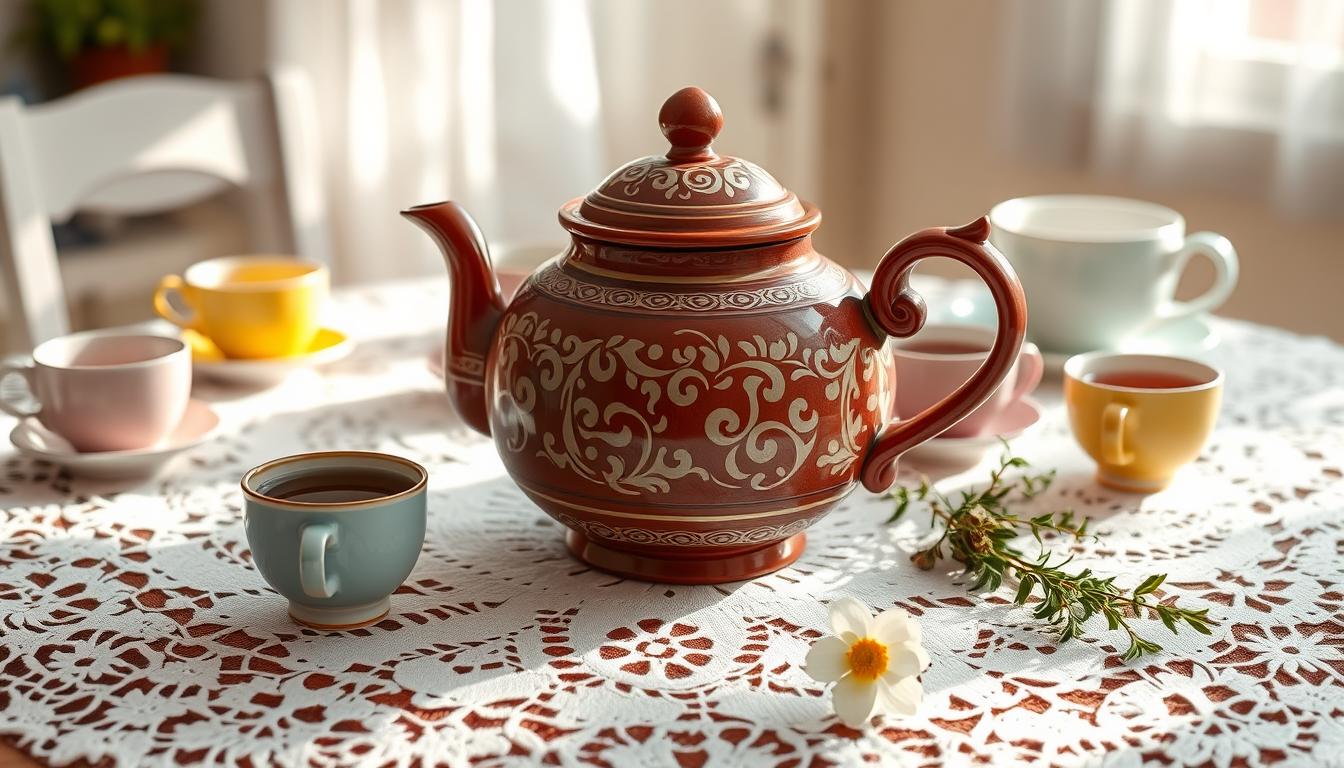Every day, 3 billion cups of tea are enjoyed around the world. The teapot is key to this daily ritual. It has been a vital part of tea culture for centuries, essential for brewing tea and enhancing the tea experience. From traditional ceremonies to casual gatherings, the teapot brings people together. This article will explore teapots, their history, and the art of brewing tea, helping you improve your tea experience with the right teapot.
Whether you love tea or are just starting, knowing about teapots is important. The right teapot can bring out the best flavors and aromas of your tea. It makes your tea experience richer and more enjoyable. Let’s explore the world of teapots and learn how to brew tea perfectly.
Key Takeaways
- Teapots are an essential component of tea culture and tea brewing.
- Understanding teapot anatomy is crucial to perfect tea brewing.
- The right teapot can elevate your tea experience and appreciation of tea culture.
- Tea brewing is an art that requires the perfect blend of technique and equipment.
- A good teapot can make all the difference in the flavor and aroma of your tea.
- Teapots come in a variety of materials, each with its own unique characteristics and benefits.
- Tea culture is deeply rooted in tradition and history, with the teapot playing a central role.
Introduction: Why the Teapot Is More Than Just a Tea Brewer
The teapot is key to tea culture, with a history that goes back thousands of years. It has changed a lot, shaped by many cultures and traditions. Knowing about the teapot history and its role in tea traditions helps us appreciate it more.
In tea culture, the teapot is more than just a tool. It brings people together, whether it’s a Japanese tea ceremony or a casual get-together. By looking into the teapot history and its journey through cultures and time, we learn more about the value of tea traditions in our lives.
The history and significance of the teapot
The teapot has been a big part of tea culture for centuries. Early ones were made from clay and ceramic. Today, teapots show off the unique styles of different cultures and tea traditions.
From China’s delicate porcelain teapots to Japan’s sturdy cast iron ones, each has its own beauty and importance in teapot history.

How the teapot evolved across cultures and time periods
As tea culture grew around the world, teapots changed to fit local tastes. In Europe, they were often porcelain with fancy designs. In Asia, they were made from wood and bamboo, showing the diversity of teapot history and design.
This variety in teapot history and design shows how important the teapot is in tea culture.
Some key moments in the teapot’s evolution include:
- Ancient China: The teapot’s birthplace, where it was first used in tea traditions over 4,000 years ago.
- Japan: The cast iron teapot became a key part of Japanese tea culture.
- Europe: Fine porcelain teapots were introduced, symbolizing luxury and refinement in tea traditions.
The Anatomy of a Teapot
A teapot is more than just a tool for brewing tea. It’s a blend of parts that make it both useful and beautiful. Knowing how a teapot is made helps us enjoy the art of tea brewing.
The main parts of a teapot are the body, spout, handle, and lid. Each part is important for how the teapot works and looks. The body holds the tea and water, the spout makes pouring easy, the handle is comfy to hold, and the lid keeps the heat in.
Key Components of a Teapot
- Body: The main container for the tea leaves and hot water
- Spout: Allows for smooth pouring and prevents spills
- Handle: Provides a comfortable grip and ease of use
- Lid: Retains heat and prevents spills
The material of a teapot also matters. Materials like ceramic, glass, or cast iron can change how the tea tastes and stays warm. When picking a teapot, think about the tea you like and how warm you want it.

In short, a teapot is a mix of parts and materials that make brewing tea better. By knowing about teapot design, tea brewing, and teapot materials, tea lovers can find the best teapot for them.
| Teapot Material | Heat Retention | Taste Impact |
|---|---|---|
| Ceramic | Good | Neutral |
| Glass | Fair | None |
| Cast Iron | Excellent | Robust |
Teapot Materials: What’s Best for Brewing?
The material of your teapot can greatly impact your tea’s taste and temperature. It’s crucial to pick the right one for your tea needs. We’ll look at ceramic, glass, cast iron, porcelain, and clay teapots.
Choosing a teapot depends on your favorite tea and brewing style. Ceramic teapots are great for delicate teas. Cast iron teapots are better for stronger teas. The material also affects how well it keeps the tea warm.
Common Teapot Materials
- Ceramic: Known for its delicate and refined brewing capabilities
- Glass: Allows for a clean and transparent brewing process
- Cast Iron: Retains heat well and is ideal for heartier teas
- Porcelain: Offers a balance between delicacy and durability
- Clay: Provides a unique and earthy brewing experience
Choosing a teapot material is a matter of personal taste and the tea you brew. By considering the material’s impact on taste and temperature, you can find the perfect teapot for your tea.
The Art of Pouring: How to Use a Teapot Properly
Mastering the art of teapot pouring is key for a smooth tea serving. Whether it’s for guests or a solo moment, the pour’s technique and angle matter a lot. Understanding tea etiquette is vital for a memorable experience.
The goal is a smooth, controlled flow when pouring. Hold the teapot at the right angle for easy flow. The pour’s art goes beyond technique, focusing on presentation and the overall experience.
Perfecting the Teapot Pour
To get the pour right, try these tips:
- Hold the teapot at a 45-degree angle for smooth flow
- Use a steady, controlled motion to pour
- Watch the tea level in the cup to avoid overfilling
By following these tips and practicing etiquette, you’ll improve your tea service. The art of pouring is crucial in the tea-brewing process. With practice, you’ll become a skilled tea server.
Preventing Spills and Drips
To avoid spills and drips, choose the right teapot and cups. Opt for sturdy teapots and secure lids, and wide-based, comfortable cups. The right equipment and etiquette make for a spill-free experience, letting you focus on the pour’s art.
Teapot Sizes and How to Choose the Right One
Size is key when it comes to teapots. The right size can greatly improve your tea experience. Whether you enjoy tea alone or with friends, picking the perfect size is important. The size of your teapot affects how much tea it can hold, which changes the flavor and aroma.
Teapots vary in size, from small for one person to big for groups. Think about how many cups you want to serve, the type of tea you like, and where you’ll store it. For big gatherings, a larger teapot is better.
Here are some things to think about when picking the right teapot size:
- Number of cups: How many cups of tea do you want to serve at once?
- Tea type: Different teas need different teapot sizes. For instance, green tea needs a smaller pot than black tea.
- Space: Think about where you’ll put the teapot, including storage and serving areas.
Some common teapot sizes include:
| Teapot Size | Tea Capacity | Suitable for |
|---|---|---|
| Small | 1-2 cups | Solo brewers |
| Medium | 3-4 cups | Small tea gatherings |
| Large | 5-6 cups | Large tea gatherings |
In conclusion, picking the right teapot size is crucial for a great tea experience. Consider the factors mentioned and choose a teapot that fits your needs, whether you’re brewing for one or many.
Teapot Styles: Classic and Contemporary Designs
Teapot design offers a wide range of choices, each with its own charm. From traditional English and Japanese styles to modern designs, the variety is vast. The design of a teapot greatly influences the tea experience, making it unique and immersive.
Traditional teapots focus on elegance and simplicity. English teapots are known for their classic shapes and delicate patterns. Japanese teapots, on the other hand, are minimalist and use natural materials. These designs have shaped the tea culture and aesthetics of their countries.
Modern Innovations in Teapot Design
Recently, modern teapot designs have become popular. Designers are exploring new materials, shapes, and styles. Some teapots have bold colors and quirky designs, while others use advanced technology like temperature control. These designs are visually appealing and improve the tea-drinking experience.
The Impact of Aesthetics on the Tea-Drinking Experience
The design of a teapot greatly affects the tea experience. A well-designed teapot can make the experience more special and indulgent. On the other hand, a poorly designed teapot can make it feel mundane. Choosing a teapot that reflects your style and complements your tea culture can create a unique and enjoyable experience.
How to Clean and Care for Your Teapot
Proper teapot cleaning and maintenance are key to keeping your teapot in good shape. It doesn’t matter if you have a ceramic, glass, or cast iron teapot. Regular cleaning stops tea stains and residue from building up.
To keep your teapot in top shape, knowing the right teapot maintenance for your material is important. For instance, ceramic teapots can be cleaned with mild soap and warm water. Glass teapots do well with a mix of equal parts water and white vinegar.
Here are some tips for tea care and teapot maintenance:
- Clean your teapot after each use to prevent tea stains and residue from building up.
- Use a soft cloth to dry your teapot and prevent water spots.
- Avoid using abrasive cleaners or scrubbers, as they can damage the teapot’s surface.
Regular teapot cleaning and maintenance will not only extend the life of your teapot but also ensure that your tea tastes its best. By following these simple tips, you can keep your teapot in top condition and enjoy perfect cups of tea every time.
Remember, proper tea care and teapot maintenance are essential to getting the most out of your teapot and enjoying the perfect cup of tea.
| Teapot Material | Cleaning Method |
|---|---|
| Ceramic | Mild soap and warm water |
| Glass | Equal parts water and white vinegar |
| Cast Iron | Mild soap and warm water, avoid abrasive cleaners |
The Role of the Teapot in Tea Culture
The teapot is key in tea culture. It plays a big role in tea ceremonies and traditions. In many cultures, the teapot is more than a vessel for tea. It symbolizes hospitality, respect, and community.
In tea traditions like Chinese Gongfu Cha and Japanese Tea Ceremony, the teapot is essential. It’s used to brew and serve tea with precision and ritual. The teapot symbolism in these cultures is deep. It stands for harmony, balance, and unity.
- Its use as a symbol of hospitality and respect
- Its role in traditional tea ceremonies and rituals
- Its representation of community and social bonding
In conclusion, the teapot is crucial in tea culture. It represents a rich set of values and traditions. Its teapot symbolism and importance in tea traditions make it a fascinating topic to explore and appreciate.
Teapot Alternatives: When to Choose Something Different
Teapots are the usual choice for making tea, but not always the best. For a single serving, a tea infuser is handy and saves space. It’s perfect for those who like simple, easy tea brewing.
For a stronger tea flavor, try a French press instead. It lets the tea leaves steep longer, giving a richer taste. Plus, French presses are easy to clean, making them great for everyday use.
Benefits of Alternative Brewing Methods
- Convenience: Tea infusers and French presses are often easier to use and clean than teapots.
- Space-saving: Alternative brewing methods can be more compact and portable, making them ideal for travel or small kitchens.
- Flavor profile: Different brewing methods can bring out unique flavors and aromas in tea, allowing for a more diverse tea drinking experience.
The right brewing method depends on your taste and the tea type. Exploring alternatives can make your tea time more exciting.
Collecting Teapots: A Hobby Worth Exploring
Teapot collecting is a hobby that mixes history, culture, and beauty. It’s perfect for those who love tea. Whether you’re new or experienced, there’s always something new to find.
Looking for teapots to start your collection? Check out antique shops, estate sales, and online sites. Teapot collecting needs a sharp eye for detail. The condition and authenticity matter a lot. Look for rare finds like antique Chinese teapots, Japanese tea sets, and European porcelain teapots.
Here are some tips to begin:
- Research different types of teapots and their history
- Learn about materials like ceramic, glass, and porcelain
- Join online groups or local clubs to meet other collectors
As you grow your collection, handle your teapots carefully and store them well. With time and effort, teapot collecting can become a lifelong hobby. It lets you enjoy the beauty and skill of these essential tea items. Whether you’re into antique teapots, tea collectibles, or just love tea, this hobby has something for everyone.
| Type of Teapot | Material | Origin |
|---|---|---|
| Antique Chinese Teapot | Porcelain | China |
| Japanese Tea Set | Ceramic | Japan |
| Rare Porcelain Teapot | Porcelain | Europe |
Teapot Etiquette: Serving Tea with Style
As we wrap up, let’s talk about serving tea from a teapot. The way you present and pour tea can make a big difference. Whether it’s a formal tea party or a casual get-together, knowing how to serve tea right is key. It makes your guests feel special and valued.
How to Serve Tea Properly from a Teapot
First, make sure the teapot is clean and warm. Pour the tea slowly and steadily. This keeps the flow even and avoids spills. Give each guest their own teacup, saucer, and any extras like milk, sugar, and lemon.
Teapot Etiquette Across Different Cultures
Tea customs vary worldwide, adding a unique touch to your service. In China, the tea ceremony focuses on the tea’s handling and pouring. Japan values the presentation of the teapot and its accessories. In the UK, a formal tea includes a teapot, milk jug, and sugar bowl.
Tips for Hosting a Tea Party with a Teapot
Make your teapot the star of your tea party. Keep it clean and attractive. Teach your guests how to pour and enjoy the tea. Remember cultural customs to make your tea party unforgettable.

